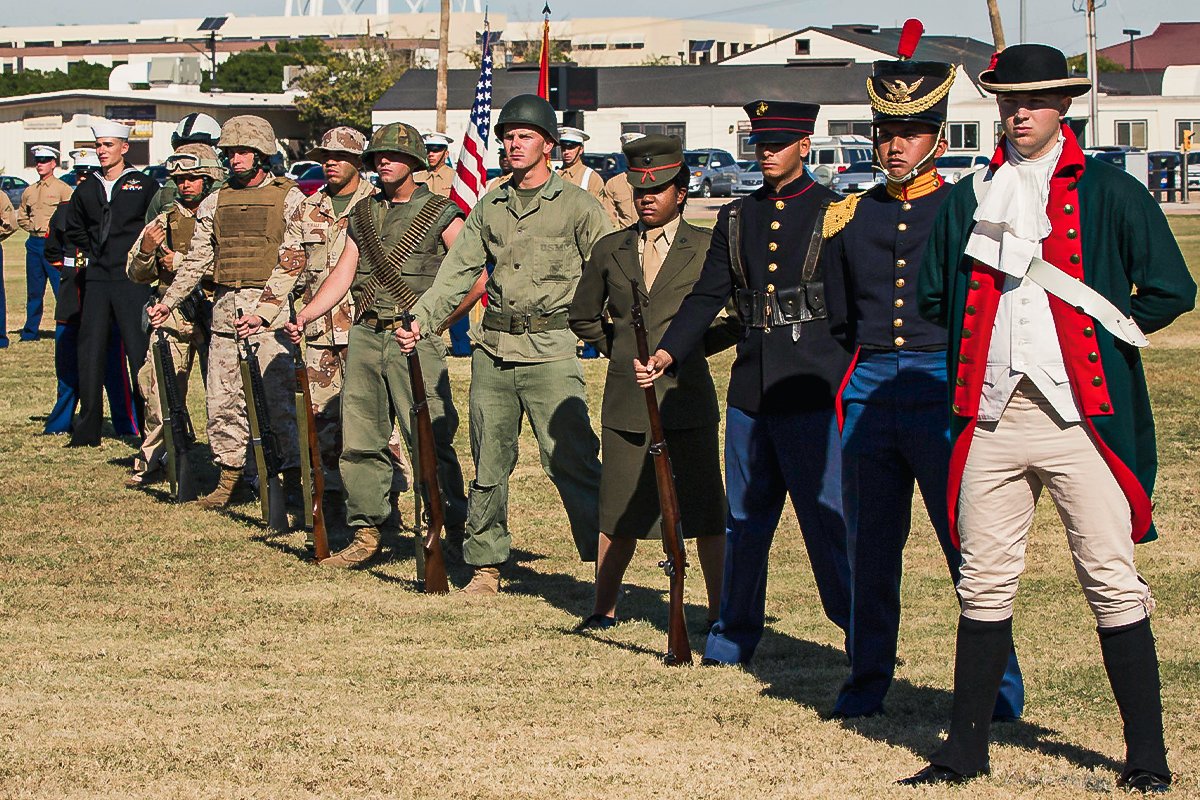
Marines from Marine Corps Air Station Yuma, Ariz. stand at parade rest during the 238th Marine Corps Birthday uniform pageant and cake cutting ceremony held at the parade deck on Thursday. The pageant consisted of Marines dressed in historical uniforms that have been worn throughout the Marine Corps’ 238 years of existence. The pageant commemorates the long lineage of men and women who have filled the Corps’ ranks for more than two centuries. Photo by PFC Reba James, courtesy of DVIDS.
Camouflage uniforms in all of their variations are standard issue for each branch of the U.S. military. However, until recently, that wasn’t the case. Although the French pioneered camouflage techniques with vehicles and gun emplacements during World War I and the British made use of Alister Mackenzie’s innovative concealment of trenches, the U.S. Navy employed their own team of camoufluers, including a small group of art students assigned to the Women’s Camouflage Reserve Corps of the National League for Women’s Service. These art students were sometimes called “hidden women” for their attempts to understand environments and landscapes similar to the battlefield.
Their experiments inside “rock suits” and “observation suits” were tested at New York’s Van Cortlandt Park before the women deployed to France with other allied units. The suits may not have been considered camo uniforms, but the principles used can be argued as early proponents of makeshift ghillie suits, prevalent concealment tactics employed by sniper teams in every major war since.
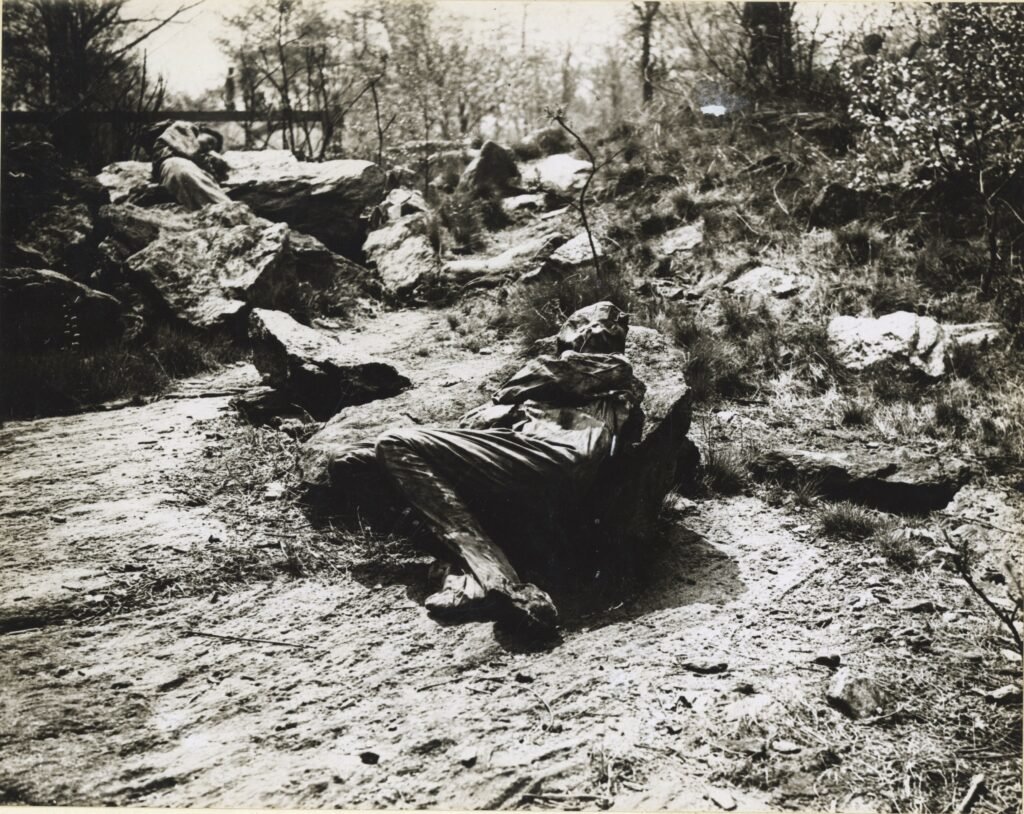
World War I may have introduced camouflage, but World War II saw the emergence of camouflage uniforms — though few and far between. In large part, the uniforms were olive drab and plain green, lacking any actual camo. During the invasion of Normandy, select infantry units of U.S. Army soldiers donned HBT camouflage uniforms made from cotton that resembled the uniforms worn by German Waffen-SS soldiers. Since most American soldiers didn’t wear camo uniforms, “friendly fire” incidents rose in frequency as a result.
In the Pacific, a few U.S. Marine Corps units, including the Marine Raiders, wore reversible M1942 camouflage uniforms referred to as “frog suits” — one side was a greenish camo for jungle warfare, and the other side was tan for the beach environments frequented during the island-hopping campaigns. The Marines adopted a similar design called the frog pattern helmet cover during the Korean War. These camouflage uniforms were also used by Brigade 2506, who were issued the frog suits by the CIA during the failed Bay of Pigs invasion.

In Vietnam, there was no official camouflage uniform for troops, but in the jungle environment, most soldiers wore an all-green “boonie suit.” The U.S. Army’s Engineer Research and Development Laboratory (ERDL) developed a four-color camo uniform in 1948 that consisted of shades of light green, dark green, brown, and black. The uniforms saw limited usage, but special operations units and reconnaissance platoons requested a need for clothing to adapt to the environment. Most notably, U.S. Army Special Forces, U.S. Navy SEALs, and members of MACV-SOG acquired the universally revered “tiger stripe” pattern as they worked deep-penetration operations alongside their South Vietnamese counterparts.
During the Cold War, the camouflage pattern that became general issue for the entire U.S. military was the M81 Woodland uniform, also known as the Battle Dress Uniform (BDU). Since its authorization in 1981, the black, brown, green, and khaki disruptive-colored design sustained prevalence in forest environments until they were phased out in the early 2000s.
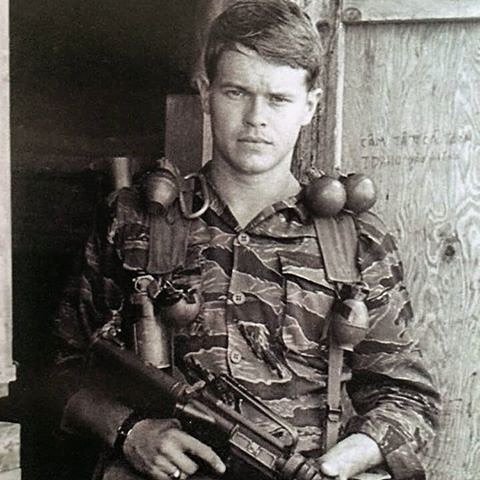
When the U.S. military fought in the Persian Gulf during the Gulf War in the early 1990s, troops wore a six-colored “chocolate chip” pattern that is often associated with General Norman Schwarzkopf, the commander of U.S. Central Command during the campaign against Saddam Hussein.
The “chocolate chip” uniform was replaced in 1992 with a three-color Desert Camouflage Uniform (DCU) that had a similar pattern as the woodland BDU’s but in different colors. This uniform was phased out in the early 2000’s as well, alongside it’s BDU counterpart.
For night missions, the military even developed a “desert night uniform,” or Parka Night Camouflage Desert as it was officially called, to be thrown over another uniform. Its goal was to reduce visibility by Soviet infrared cameras and night vision goggles.
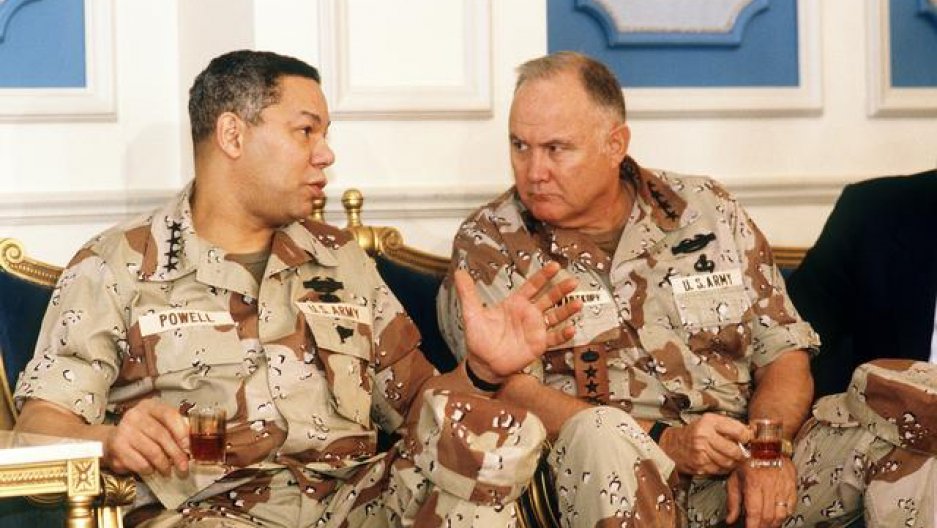
Since the woodland and desert uniforms were widely used among all branches of service, the U.S. Marine Corps decided they needed their own unique brand. With the assistance of retired U.S. Army Lieutenant Colonel Timothy O’Neill, one of the leading camouflage experts in the world, the MARPAT (Marine Pattern) became the exclusive uniform of the Marines in 2002. The Marine Corps even patented the green-and-tan uniforms, inserted emblems on the pockets, and stitched Marine Corps trademarks on them to reinforce the point that nobody else could wear them.
“’Digital’ camouflage is actually a misnomer, based on the superficial resemblance of these patterns to quantized or coarse digital images,” said O’Neill. “In fact, the patterns of squares (or whatever shape we use) is employed to model the texture of typical backgrounds using a mathematical function. We could use hexagons or shapeless blobs as well, except that it is easier to render complex patterns by computer using squares. It is easy to misunderstand the purpose and mechanisms of this kind of design, which is why so many measures that try to use the approach without insight fall short.”

Since the Marines had adopted their own uniforms, the rest of the branches had to come up with something comparable on the fly. What followed was some questionable decision-making and millions of dollars wasted when it comes to digital patterns of camouflage.
The Army developed the Universal Camouflage Pattern (UCP) in 2004, which was implemented in the new Army Combat Uniform, or ACU. The three-colored pattern consisting of green, tan, and gray was universally disliked by ground combat soldiers in particular throughout it’s use in the Global War on Terrorism (GWOT). Their displeasure cost $5 billion and is considered a colossal failure as the “universal” camouflage was essentially useless in any environment including arctic, desert, jungle, and urban.

The U.S. Navy decided to join in the mix in 2010 with what is sometimes called “aquaflage” or “the blueberry.” The Type I uniform was a blue-digital pattern that all sailors were authorized to wear — except for Naval Special Warfare — during working hours on battleships, aircraft carriers, and shore duties. The Navy has recently transitioned from the Type I blue pattern to a green MARPAT-style Type III camouflage uniform, only seven years after the initial implementation.
The U.S. Air Force also developed their own camo uniforms to replace old woodland pattern. Largely by following the guidance of the Army, they introduced the Airman’s Battle Uniform (ABU) in 2007.

The gray “tiger stripe” may have looked cool at first glance, but its reputation amongst Special Tactics operators and other Air Force ground units while in theater in the Middle East wasn’t positive.
“Turns out the ABU’s I’d purchased were not authorized for wear outside the wire,” one airman told Time Magazine about his 2011 deployment to Afghanistan. “Instead, the Air Force provided me with an outfit called the ABS-G, which stands for Airman Battle System – Ground. This ‘tactical ensemble’ – not a uniform, the description emphatically insisted – was a set of pants and shirts which matched the Airman Battle Uniform’s camo pattern but were fire resistant, lighter, softer, and slightly different in a handful of other ways (think zippers, Velcro, pockets).”
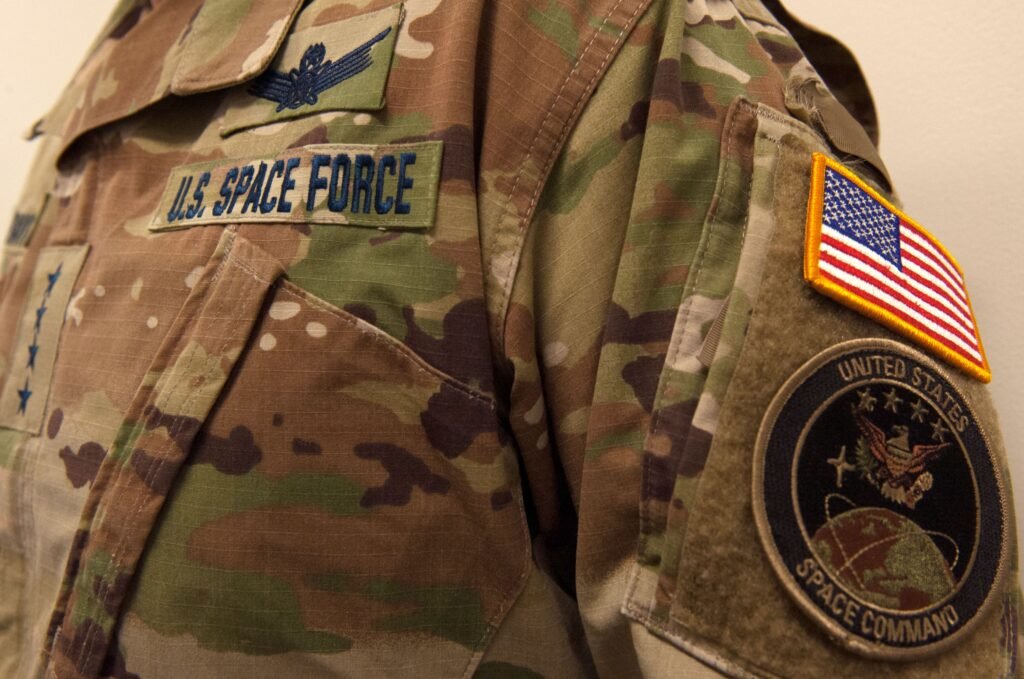
The Army and Air Force, along with their respective special operations units now use the Operational Camouflage Pattern (OCP), a Multicam pattern of muted green, light beige, and dark browns. It’s considered a significant upgrade from the digital UCP pattern it replaced.
Today, Naval Special Warfare units sport the AOR1 and AOR2 digital patterns, which come in both desert and woodland variants. As innovative camouflage techniques progress with the increase of technology and the understanding of environments, camouflage uniforms are here to stay — which is clearly displayed by the newly formed U.S. Space Force and their efforts to find a suitable pattern for the final frontier.

Matt Fratus is a history staff writer for Coffee or Die. He prides himself on uncovering the most fascinating tales of history by sharing them through any means of engaging storytelling. He writes for his micro-blog @LateNightHistory on Instagram, where he shares the story behind the image. He is also the host of the Late Night History podcast. When not writing about history, Matt enjoys volunteering for One More Wave and rooting for Boston sports teams.
BRCC and Bad Moon Print Press team up for an exclusive, limited-edition T-shirt design!
BRCC partners with Team Room Design for an exclusive T-shirt release!
Thirty Seconds Out has partnered with BRCC for an exclusive shirt design invoking the God of Winter.
Lucas O'Hara of Grizzly Forge has teamed up with BRCC for a badass, exclusive Shirt Club T-shirt design featuring his most popular knife and tiomahawk.
Coffee or Die sits down with one of the graphic designers behind Black Rifle Coffee's signature look and vibe.
Biden will award the Medal of Honor to a Vietnam War Army helicopter pilot who risked his life to save a reconnaissance team from almost certain death.
Ever wonder how much Jack Mandaville would f*ck sh*t up if he went back in time? The American Revolution didn't even see him coming.
A nearly 200-year-old West Point time capsule that at first appeared to yield little more than dust contains hidden treasure, the US Military Academy said.












